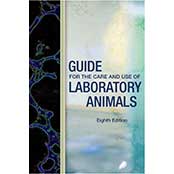1 KEy CONCEPTS 1
Applicability and Goals, 2
Intended Audiences and Uses of the Guide, 3
Ethics and Animal Use, 4
The Three Rs, 4
Key Terms Used in the Guide, 5
Humane Care, 6
Animal Care and Use Program, 6
Engineering, Performance, and Practice Standards, 6
Policies, Principles, and Procedures, 7
Must, Should, and May, 8
References, 8
2 ANIMAL CARE AND USE PROGRAM 11
Regulations, Policies, and Principles, 12
Program Management, 13
Program Management Responsibility, 13
The Institutional Official, 13
The Attending Veterinarian, 14
The Institutional Animal Care and Use Committee, 14
Collaborations, 15
Personnel Management, 15
Training and Education, 15
Occupational Health and Safety of Personnel, 17
Personnel Security, 23
Investigating and Reporting Animal Welfare Concerns, 23
Program Oversight, 24
The Role of the IACUC, 24
IACUC Constitution and Function, 24
Protocol Review, 25
Special Considerations for IACUC Review, 27
Postapproval Monitoring, 33
Disaster Planning and Emergency Preparedness, 35
References, 35
3 ENVIRONMENT, HOUSING, AND MANAGEMENT 41
Terrestrial Animals, 42
Terrestrial Environment, 42
Microenvironment and Macroenvironment, 42
Temperature and Humidity, 43
Ventilation and Air Quality, 45
Illumination, 47
Noise and Vibration, 49
Terrestrial Housing, 50
Microenvironment (Primary Enclosure), 50
Environmental Enrichment, 52
Sheltered or Outdoor Housing, 54
Naturalistic Environments, 55
Space, 55
Terrestrial Management, 63
Behavioral and Social Management, 63
Husbandry, 65
Population Management, 75
Aquatic Animals, 77
Aquatic Environment, 77
Microenvironment and Macroenvironment, 77
Water Quality, 78
Life Support System, 79
Temperature, Humidity, and Ventilation, 80
Illumination, 81
Noise and Vibration, 81
Aquatic Housing, 82
Microenvironment (Primary Enclosure), 82
Environmental Enrichment and Social Housing, 82
Sheltered, Outdoor, and Naturalistic Housing, 83
Space, 83
Aquatic Management, 84
Behavior and Social Management, 84
Husbandry, 84
Population Management, 87
References, 88
4 VETERINARy CARE 105
Animal Procurement and Transportation, 106
Animal Procurement, 106
Transportation of Animals, 107
Preventive Medicine, 109
Animal Biosecurity, 109
Quarantine and Stabilization, 110
Separation by Health Status and Species, 111
Surveillance, Diagnosis, Treatment, and Control of Disease, 112
Clinical Care and Management, 113
Medical Management, 114
Emergency Care, 114
Recordkeeping, 115
Surgery, 115
Training, 115
Presurgical Planning, 116
Surgical Facilities, 116
Surgical Procedures, 117
Aseptic Technique, 118
Intraoperative Monitoring, 119
Postoperative Care, 119
Pain and Distress, 120
Anesthesia and Analgesia, 121
Euthanasia, 123
References, 124
5 PHySICAL PLANT 133
General Considerations, 133
Location, 134
Centralization Versus Decentralization, 134
Functional Areas, 135
Construction Guidelines, 136
Corridors, 136
Animal Room Doors, 137
Exterior Windows, 137
Floors, 137
Drainage, 138
Walls and Ceilings, 138
Heating, Ventilation, and Air Conditioning (HVAC), 139
Power and Lighting, 141
Storage Areas, 141
Noise Control, 142
Vibration Control, 142
Facilities for Sanitizing Materials, 143
Environmental Monitoring, 143
Special Facilities, 144
Surgery, 144
Barrier Facilities, 145
Imaging, 146
Whole Body Irradiation, 147
Hazardous Agent Containment, 148
Behavioral Studies, 149
Aquatic Species Housing, 150
Security and Access Control, 151
References, 151
ADDENDUM 155
APPENDICES
A ADDITIONAL SELECTED REFERENCES 161
Subject Matter, 161
Use of Laboratory Animals, 162
Alternatives, 162
Ethics and Welfare, 163
Experimental Design and Statistics, 164
Research and Testing Methodology, 165
Program Management, 167
General References, 167
Laws, Regulations, and Policies, 168
Education, 169
Monitoring the Care and Use of Animals, 169
Occupational Health and Safety, 170
Environment, Housing, and Management, 172
General References, 172
Environmental Enrichment, 173
Genetics and Genetically Modified Animals, 175
Species-Specific References—Environment, Housing, and
Management, 176
Agricultural Animals, 176
Amphibians, Reptiles, and Fish, 178
Birds, 179
Cats and Dogs, 180
Exotic, Wild, and Zoo Animals, 181
Nonhuman Primates, 182
Rodents and Rabbits, 184
Other Animals, 187
Veterinary Care, 188
Transportation, 188
Anesthesia, Pain, and Surgery, 188
Disease Surveillance, Diagnosis, and Treatment, 190
Pathology, Clinical Pathology, and Parasitology, 190
Species-Specific References—Veterinary Care, 191
Agricultural Animals, 191
Amphibians, Reptiles, and Fish, 192
Birds, 193
Cats and Dogs, 193
Exotic, Wild, and Zoo Animals, 193
Nonhuman Primates, 194
Rodents and Rabbits, 194
Design and Construction of Animal Facilities, 196
b U.S. GOVERNMENT PRINCIPLES FOR THE UTILIZATION
AND CARE OF VERTEbRATE ANIMALS USED IN TESTING,
RESEARCH, AND TRAINING 199
C STATEMENT OF TASK 201
D AbOUT THE AUTHORS 203
INDEx 209
